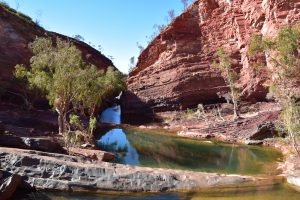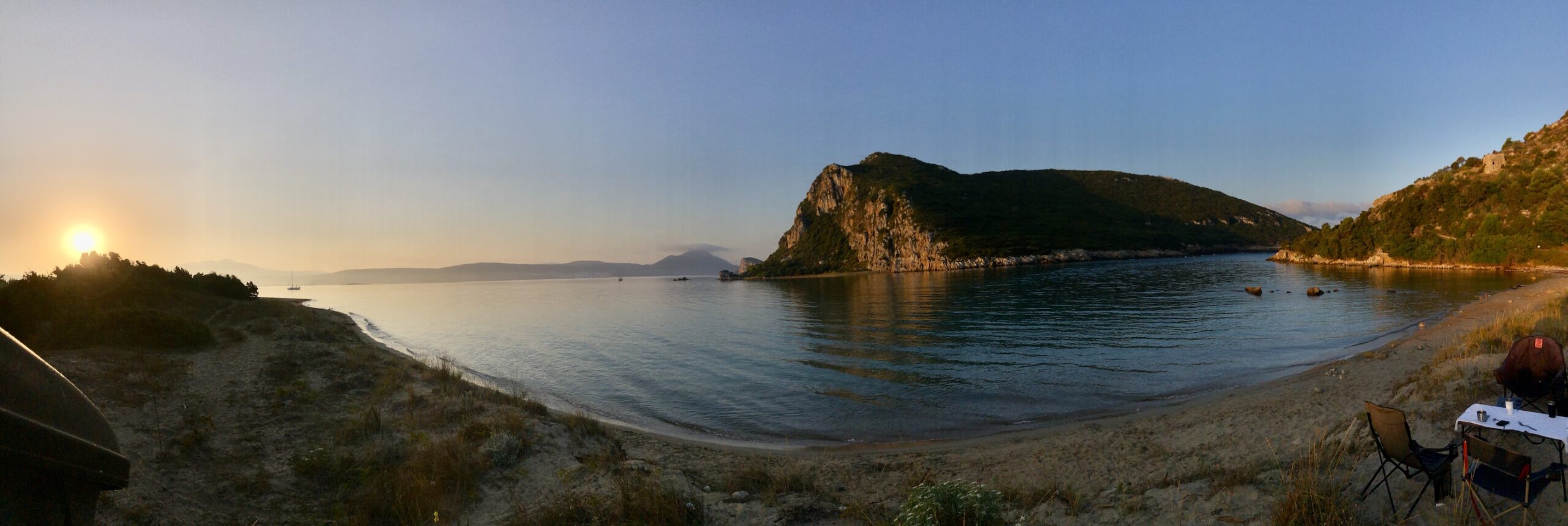It was ten days into traveling “the Loop”, when we found out that Voukefalas had not been registered and therefore not insured. Here in Australia this should be done through registering in the department of transportation. We were under the impression, as in other countries we have been through, that we were covered under our Carnet de Passage. Oops! No drama! After a couple of helpful messages through overlanders’ forums online, we found out exactly what was needed.
It was Rochelle’s idea to have it sorted out here in Kalgoorlie because in smaller cities, matters like this are usually solved with far less paperwork and questions about how we got there without it until today (therefore no fines). So after a recommendation from a lady in the Department of Transportation, we were off for the needed typical mechanical inspection of Voukefalas. In reality, they were more impressed by the left-hand drive vehicle than actual checking Voukefalas.

Anyway, after a bit of persuasion and a 20$ tip, we passed and got the precious paper. With that in hand, we ran back, as closing time was approaching, and got legalized by the Department of Transportation. Yes! We were finally legal and able to start our course towards the west coast.


At a quick pace, in order to catch up some time, we went through sleepy Lancelin and the laid-back crayfishing (rock lobster) community of Cervantes before we entered the Pinnacles Desert. Here we timed ourselves (something rare for us) to catch the sun setting, a rather impressive sight that set our cameras on fire. Heading further north on the Indian Ocean Drive, we passed Jurien Bay (pit stop for dinner) before we called it a night at a small lookout off Green Head, where we were awarded with panoramic views over the coast. The next morning we pushed to Geraldton, the capital of the Midwest and the largest town between Perth and Darwin. We found Gero to be a blend of big-city sophistication with small-town friendliness. After visiting some of Rochelle’s childhood friends, we continued northbound to Port Gregory, a tiny seaside village, on the far side of the mysterious Pink Lakes, before we reached Lucky Bay.


This wonderful white sand beach, protected from a reef with bright turquoise waters, was our base for the upcoming couple of days. After camping in a basic caravan park right on the beach, with long drop toilets as the only facilities, we were up for some lazy beach days around the bay.

Then there was Kalbarri, with its red sandstone cliffs hanging over the Indian Ocean. Almost at the end of this small town is where Kalbarri National Park begins. Here the beautiful Murchison River snakes through steep gorges before ends up in Gantheaume Bay, while on land, kangaroos, emus and thorny devil lizards and in the ocean, whales breaching offshore, complete the highlight of the park making it worth to stop for a day or two.


Here, being so close to the ocean, we made sure that our meals were provided by a local fisherman’s truck every day and cooked in the back of Voukefalas. Yum! Fresh fish and prawns. You can’t go wrong!
After a strong downpour of rain, our quest pushed us further north towards Shark Bay, a spectacular coastline of turquoise lagoons, barren peninsulas and white-sand beaches. It’s the westernmost part of the Australian mainland and one of WA’s most biologically rich habitats. Hamelin Pool, our first stop on the peninsula, was a marine reserve with the world’s best-known colony of stromatolites. In case you wonder if we knew anything about stromatolites from before, the answer is “no”. But we were impressed to read that “these coral-like formations consist of cyanobacteria almost identical to organisms that existed 3.5 billion years ago, and through their use of photosynthesis, are considered largely responsible for creating our current atmosphere, paving the way for more complex life”. Right next to Hamelin Pool was the deserted Shell Beach, where we had planned to overnight.

Unfortunately, as we pulled in the parking lot there was a big “no camping” sign and therefore we pushed onwards. On route, we passed the turn-off for Useless Loop and Steep Point, the Australian mainland’s most westerly tip. We didn’t take that turn because getting there involves a damaged track of three hours of corrugations, so the decision was made to let that one go.


The next day and as our luck in finding great spots changed, we entered François Peron National Park, a whole peninsula north of Denham with low scrub, salt lakes and red sandy dunes. Here there were scattered rough camp sites, alongside brilliant white beaches, all accessible only via 4WD tracks. In our campsite, except the magnificent sunsets each day, we were entertained by dolphins in a playful mood, so if you get here keep an eye out in the crystal waters. After a couple of nights in the peace and quiet of the national park, we reached our final stop in the peninsula, Monkey Mia, where most visitors come every morning to watch wild dolphins in the shallow waters. Although we were lucky in François Peron National Park to have our own private dolphin show, we gave in and the next day we were there. A bit of a set up scene really, as dolphins know they will be fed and that is why they show up, it was done very professionally making sure that the interference of humans is kept to the absolute minimum with the wild life.

Leaving the peninsula behind, we entered the Yinggarda country, where at the mouth of the Gascoyne River sits fertile Carnarvon. This is the base of WA’s fresh product source with fruit and vegetable plantations and thriving fishing industry. What a pleasant stopover for restock before we pushed onwards. We picked not to stay here very long and headed via the North West Coastal Hwy towards the coast, north of Carnarvon that is wild, windswept and desolate. Not many make it this far out here, but those who do are rewarded with summer temperatures, relentless winds, amazing marine life and breathtaking scenery, a truly magical experience.


Right of the Hi-Way 1, from the Tonto dirt, after 10km we came across the Quobba Station, with plenty of camping spots, a small store and legendary fishing. Further on, 60km north of the homestead, was Red Bluff, a spectacular headland with a wicked surf break and excellent fishing, as well as the southern boundary of Ningaloo Marine Park. As we found Red Bluff to be overtaken by the surf crowds and overpriced, we back tracked in the Quobba Station and called in for a couple of days.
From there onwards, we entered the World Heritage–listed Ningaloo Marine Park that protects the full 300km length of the Ningaloo Reef, from Red Bluff far to the south to Bundegi Reef on the eastern tip of the peninsula. This reef has a staggering array of marine life – sharks, manta rays, humpback whales, turtles, dugongs, dolphins and another 500 species of fish call this reef home. For us, as keen divers, here was the place we had picked to hit the water with a regulator in our mouth. More precisely just north of the Tropic of Capricorn, in the tiny seaside village of Coral Bay.


This small town though was chockers (full, for the non Aussie speakers) and therefore our plans to use it as a base for outer-reef diving would not work out, so we saved our dives for the other access town to the reef in Exmouth, 152km further north. As we found out, development here in Coral Bay is strictly limited, so prices were noticeably higher in both food and accommodation. The one street town with a white-sand beach right in its footstep is small enough to enjoy on foot, making it though very popular with families. So after a quick couple of days, we were ready to move towards Exmouth. On our way out and in pursuit of a stunning isolated beach, we managed to get our car severely stuck in the sand while the tide was coming in. Without any other option and while I was struggling digging sand in order to get Voukefalas to move, Rochelle ran along the beach and found help. Thankfully we managed to get Voukefalas moving and away from the danger. Lesson learned and moving onwards! Upon entering Exmouth, you immediate notice that tourism is the main economic support of the town and therefore there were many more options than the tiny Coral Bay.

Once a WWII submarine base, nowadays Exmouth, with World Heritage Ningaloo Reef on its door step, would make up for the perfect base to dive. With our dive dates arranged, we pushed just 80km outside the city and entered Cape Range National Park, where limestone peaks and gorges offer wildlife watching opportunities, including the rare black-flanked rock wallaby, five types of bat and over 200 species of bird (from the information we got from the visitor centre).


Spectacular deep canyons cut dramatically into the range, before emptying out onto the wind-blown coastal dunes and turquoise waters of Ningaloo Reef. What a perfect place to base yourself! As for the diving, it was definitely worth waiting for, as we were awarded with colourful coral gardens full of marine life and a couple of humpback whales swimming along our dive boat on our way back. On land, and with home base one of the many basic camps inside the park, we enjoyed some beach time while waiting for Rochelle’s sister’s family to turn up and the real fun to begin. Beach days and gorge exploring were the main sightseeing, along with some always great quality time spent among the young members of the family. Late at night and after the children were in bed, the four of us had many meaningful discussions over a bottle or two of wine, under the Milky Way. What else can someone expect for a perfect vacation?


We spent a total of ten days exploring that area before we said goodbye to the family as well as the coast and turned inland towards Karijini National Park. A gem, as we found out, home to spectacular gorges, remote peaks, deep tranquil pools and abundant wildlife. Top destination in any tourist brochure, Karijini with its narrow, breathtaking gorges, hidden pools and spectacular waterfalls was for us one of WA’s most impressive attractions. Upon arrival, we were astonished by the red ranges and deep, dark chasms, filled with abundant wildlife and different plant species. Here, kangaroos, rock wallabies, snappy gums and wildflowers have taken over the plains, (not that we saw any) while quiet pools complete a fantastic scenery leaving any visitor speechless (including us).We spent almost all five days of our stay trekking the many of the parks magnificent gorges. A truly fairytale landscape that made it straight to the list of our favorite places we visited around the world!


Close to the park, the getaway town of Tom Price was the place we restocked, reset and got permission to drive through Rio Tinto mining companies, unsealed road alongside the railway to our next destination, the Millstream Chichester National Park. This tranquil national park is one of the most important indigenous sites in WA, with swimmable waterholes of the Fortescue River forming cool, lush oases. With only one overnight stop planned, we made sure that we checked out all the highlights before we hit the tarmac once again with destination Karatha.


That single night though and the stunning sunrise the next day, made us change completely our minds about the way we see Australia’s outback and we are now looking forward to getting back to it as soon as possible…













Hi to all. Just talked to Veronica and she gave me this
Hope you both are well also Mum &Dad Say hi from me
Love to all. 😘👍🏊🏊